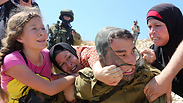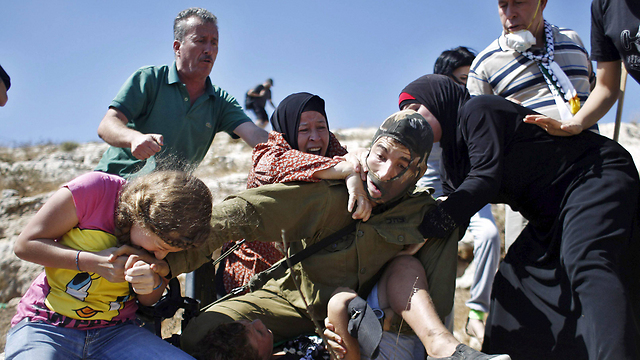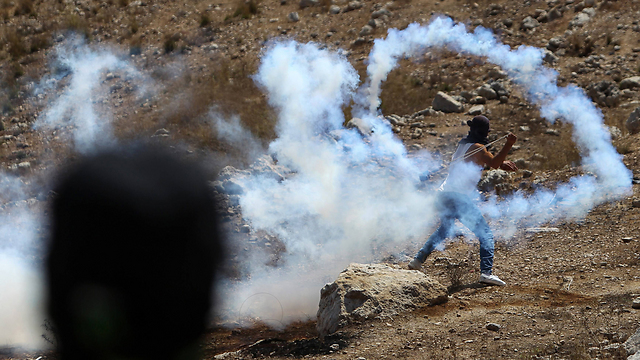
Nebi Salah incident. In the Israel-Palestine war, every act has more than one reason
Photo: AFP

Nebi Salah footage a reflection of Israel
Op-ed: The images of a young girl and two women struggling with an Israeli soldier grasping a 12-year-old Palestinian boy's neck illustrate not only what the occupation is doing to the Palestinians, but mostly what it is doing to the IDF and to the State of Israel.
Nine-year-old Salam Tamimi is a fair-haired child with blue eyes and a straight back – Palestine's poster child. I met him on Tuesday afternoon in his house's backyard in the village of Nebi Salah.
The next day I spoke to his father, Bassam, on the phone. Why did you name him Salam, peace, I asked. "For two reasons," he replied. "First, when he was born I began changing my opinion about resisting the occupation. I thought that there may be another way. I believed peace could be reached."
Staged Incident?
Daily Mail and Telegraph change headlines critical of Israel after claims arise Palestinian family photographed clashing with IDF soldier are known provocateurs and that incident was staged.
And what was the other reason, I asked.
"The other reason was that I had a friend named Salam. The Israelis killed him during the intifada."
It's almost a predestination: In the Israel-Palestine war, every act – even the birth of a child – has more than one reason. Sometimes the reasons complement each other; sometimes they contradict each other.
The demonstrations which leave the Hawajeh company's gas station, at the entrance to Nebi Salah, every Friday have more than one reason too. One of these protests, last Friday, was documented on video. Muhammad Tamimi, Salam's brother, raised his arm as if he were intending to throw a stone. A soldier jumped on him and tightly grasped the sobbing child's neck. Several women, including the child's mother and sister, attacked the soldier, exposed his face and began hitting him; the sister, Ahed, bit his hand.
The outcome could have been extremely grave, catastrophic, had the solder and his friends opened fire. But the footage was difficult, even shocking. It illustrated not only what the occupation is doing to the Palestinians, but also, and mainly, what it is doing to the IDF. What it is doing to the State of Israel. Whether we admit it or not, that soldier is us.
Nebi Salah is a relatively small village, with about 600 people. Most residents support Fatah; few support Hamas. The village sits on the top of a high mountain, east of Ramallah. The Tamimi family's house is located at the southwestern end of the village. It overlooks a splendid view: The coastal plain and sea in the west, the Um Safa forest in the south, and a large settlement on its margins with two names – Halamish and Neve Tzuf. Road 465, which begins west of the Green Line and ends on the Ramallah-Nablus road, near the settlement of Ofra, passes through the valley between Nebi Salah and Halamish-Neve Tzuf.
After 1967 I used to hike in these mountains, the Gofna Mountains, quite often. The olive groves, the orchards, the villages stuck to the mountains, the wells, the springs – they all seemed as if they had been taken from the pages of the Bible.
We have grown stronger since then. Near the modest spring of Nebi Salah there is now a brown sign, similar to the guiding signs within the Green Line, but completely illegal. "Maayan Meir" (Meir's Spring), the sign reads. Meir is the late Meir Segal, one of the settlement's founders. A sign placed alongside the spring mentions the deceased, praises the place's renovation and quotes a song by Israeli lyricist Yoram Taharlev: "I had a spring between the wild weeds… The small piece of God."
The settlers got rid of the weeds and set up benches instead – one of them in the place where the spring comes out of the rock. Picnic tables were dispersed in the area, a pergola was built, fruit trees – pomegranate, fig, olive – and ornamental trees were planted and three small pools were dug for washing. A drizzle of water comes out of the spring and fills the pools.
When I was there this week, I saw a small flag of Israel on the ground. After picking it up, I realized why it had been covered with swarms of flies: Someone, likely a hostile person, defecated near the spring and covered his body wastes with the Israeli flag. That's a type of protest too.
The battle over the spring
Why Nebi Salah, I asked an IDF officer who served in the area.
"The story," he said, "starts with a plot of citrus trees, mainly lemons, near the spring, with beehives inside. In 2009, Jews set fire to the plot as part of 'price tag' activities. The plot belonged to a young man from Deir Nidham, a nearby village. And then the protests started.
"We asked the Nebi Salah mukhtar why the protests were going on. First of all the spring, he said. We checked: There are three large water pools down the road. Soldiers used to bathe in them. We asked the soldier to stop. The staff officer for archaeology issued demolition orders in 2012 for everything the settlers built around the spring. The orders have not been executed to this very day. I don’t know why.
"In 2011, we arranged for Nebi Salah's residents to visit the spring on weekdays, apart for Friday because it creates a security problem for the settlers. The Halamish residents were very angry. The Palestinians would come and create provocations – place a flag of Palestine instead of a flag of Israel, cause damage.
"They also claimed that the settlers had erected a fence on their private lands. We checked: The fence was built without a permit. The Civil Administration's supervision unit knocked down the fence, but left it on the ground. Both sides were angry – the settlers, because we knocked it down, and the Palestinians, because they couldn’t work their lands.
"With Deir Nidham we solved things: They received help from the Red Cross. But Nebi Salah kept making new demands. They demanded to return to small plots which were expropriated from them in the 1970s. We checked: The plots were in the heart of the settlement. A grocery store was erected on one of them, and a swimming pool on the other. How will we give them back?
"Nonetheless, we couldn’t understand why they were still protesting. Some said, it's the money. They get money from Turkey. And some said, it's the girls from the European protest organizations. They see a Swedish girl arriving to protest, so they go out too.
"Once we said, maybe we should ignore them. Let them protest. But then they continued walking down the road, reached the Halamish regimental policeman and threw Molotov cocktails into the community. We realized that there was no choice, we had to push them into the village."
I asked Bassam Tamimi what was the reason for the protests. "It's a long list," he said. "The expropriated lands, the spring, the olive trees which have been cut off, the demolished homes, the occupation in general. The plot which was taken in 2009 led to demonstrations, but our battle began in as early as 2000, during the intifada."
Ahed, his 14-year-old daughter, was documented three years ago scolding a soldier. The blonde, blue eyed, self-confident girl with the long braid became a media star. Have you received money to fund the protests, I asked.
He denied it. "We don’t receive money from anyone. There is a Palestinian coordination committee which occasionally funds a lawyer. That's all."
Nebi Salah is filled with blonde people, I said. I assume everyone asks where you came from.
He laughed. "We came here 100 years ago," he said. "We came from Hebron. According to the stories, our forefathers were Europeans who converted to Islam. But those are just stories."
Thanks to the video, the Tamimi family is now Palestine's hero. On Thursday they were supposed to travel to Ramallah for a festive meeting with the rais, Palestinian President Mahmoud Abbas.
Wipe them off the map
At the end of the War of Independence, the State of Israel sought to erase the Arab neighborhoods and villages which had emptied out. At first they even burned furniture. The fear that the Arabs would return to their homes sped up the destruction process.
Later on, when they remembered that there were hundreds of thousands of immigrants seeking a roof over their heads, they stopped destroying and began housing. But the effort to conceal the historical chapter didn’t stop. Names of streams, mountains, communities and streets were converted into Hebrew. It was a natural, almost necessary move: That's how a nation acts upon reaching independence in its own state after 2,000 years.
For the hard core of the settlers, 1967 is like 1948, and what applies to the West Bank applies to the State of Israel as well. Several years ago, the Mateh Binyamin Regional Council launched a campaign to replace the names of all the springs in the area. It's not based on any law, but the army's hands are tied.
Ein Bubin, near the village of Deir Ibzi'a, turned into Danny's Spring – named after Danny Gonen who was murdered there. A monument commemorating the murder was erected on private Palestinian land. It was inaugurated by Uri Ariel, a government minister. The sign pointing to the spring crosses a red sign placed by the State, which bans entry for security reasons (the red signs are a bluff in itself: They allegedly bar everyone from entering, apart from Palestinians, but they are in fact intended for Jews only. Israel's Arabs are invited to enter. The settlers are not invited, but they enter anyway).
It's all part of the "winking" culture, it's all Israbluff. From a legal point of view, the IDF is the sovereign in the area. It is the supreme authority. In reality, the settlers are the sovereigns. The settlers' leadership wants to do the Palestinians what it is doing to the springs – wipe them off the map. It's its settlement vision; it's its political vision.
The problem is not with Knesset Member Bezalel Smotrich (Bayit Yehudi) or with Minister Uri Ariel. They are acting according to their faith. We should not blame the person who steals, our forefathers said, but the hole which allowed him to steal. The hole is the IDF; the hole is the legal system; the hole is the government.
In the current government's cabinet, the settler lobby holds a majority; the Bayit Yehudi ministers are theirs. The Likud ministers are with them. The leftist mark of the cabinet is Shas Chairman Aryeh Deri. He is the balancing factor. On issues related to the settlements, he is sometimes joined by Defense Minister Moshe Ya'alon. The settlers have insulted him, and he is finding it difficult to forgive.
Prime Minister Benjamin Netanyahu talks about a political horizon – but the horizon, as a horizon does, will never arrive. Everyone realizes that – and Abbas is now realizing it too. In the best-case scenario, the two-state solution has been given the life sentence; in the worst-case scenario, it has been executed.
The statement issued by Abbas last week, that he plans to resign from all his positions, has drawn mountains of interpretations. Netanyahu and Ya'alon are certain that it's a musical chairs game: Abbas wants to dismiss a number of rivals and promote a number of associates. Israel shouldn't be bothered by it.
This interpretation has been accepted by some Palestinian sources as well. It may be true, IDF sources warn, and it may not be true. There are contradicting signs. Abbas is deliberating: He hasn't decided which direction he is headed in yet. The frustration, the anger and the desperation are real.
We should not rule out the possibility that he will turn his speech at the United Nations General Assembly in late September into a pivotal speech, a reality-changing speech. The 22nd anniversary of the Oslo Accords is coming up. He may announce the annulment of the agreements, some or all of them.
Only two promises remain from Oslo: The Paris Protocol, which regulates the economic relations, and the security coordination. He may cancel the first, and perhaps the second as well. He may announce the dismantlement of the Palestinian Authority and place responsibility for its population on the Israeli government's shoulders.
The concern many be exaggerated. The hunger for power, money, respect and the loyalty to the organization will keep Abbas in the Muqata'a in the capacity of the guardian of Israel.
But we are not just talking about differences in estimates. Netanyahu sees Abbas as an enemy, and the political battle as a war. He seeks to strengthen Hamas, because Abbas is threatening him in the international community and Hamas isn’t. Israel could pursue an Abbas-mediated ceasefire with Hamas. Netanyahu is saying no to that. He is pursuing a ceasefire with Hamas against Abbas.
MK Esawi Frej (Meretz) told me last week that Abbas was deeply impressed by the things President Reuven Rivlin said in the interviews marking his first year in office. Rivlin had raised the possibility of establishing a confederation between Israel and Palestine. "They only have to make me the offer," Abbas said.
Who is the source, I asked. Frej replied: Nahi Mena, one of Abbas' associates, a captain in the Palestinian airline. Mena is the Palestinian president's personal pilot.


















